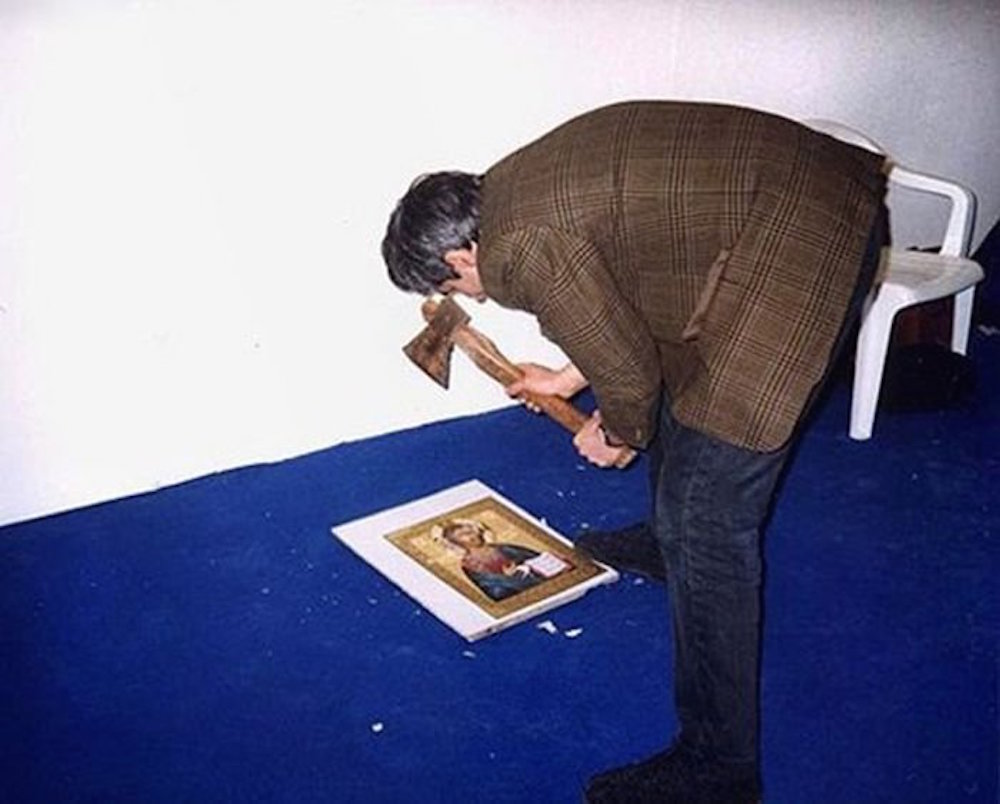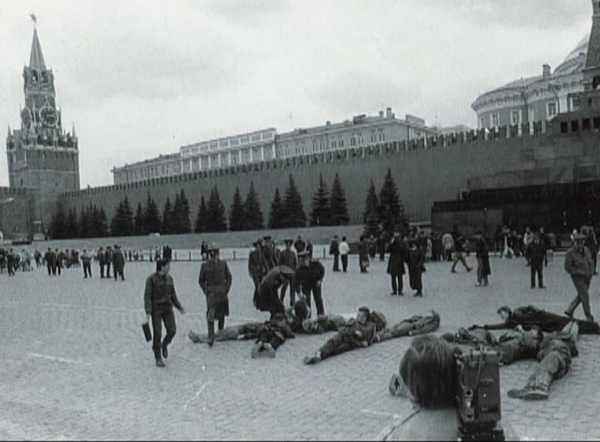Beyond Pussy Riot: 7 controversial actionist-artists you should know

Nearly everyone has heard of Pussy Riot and Pyotr Pavelensky, but what about the Russian artists who heralded political performance art of the 90s and Noughties?
To mark the 100th anniversary of the Russia’s October Revolution, London’s Saatchi Gallery are hosting Art Riot: Post-Soviet Actionism, a show dedicated to 25 years of Russian political performance art. Though the link is somewhat tangential — after all, actionism was born in the fierce post-Soviet era — the performances have the fervour of revolutionary art from decades before.
The stars of the exhibition are without a doubt the most controversial names in Russian art of recent years — Pussy Riot and Pyotr Pavlensky, as well as art group Blue Noses, whose most famous artwork depicts two Russian policeman kissing in a birch tree forest. Yet the legacy of actionist art is not limited to these names alone. We look back at the figures and collectives who have staged mass protests, caused scandals and nailed themselves all in the name of political art.
Oleg Kulik
Kiev-born Oleg Kulik became widely known in the mid- to late-1990s as the “dog-man” for impersonating the animal in his performances. His first appearance as a human-dog was in 1994, when in November fellow artist Alexander Brenner walked him on a leash outside the Marat Guelman gallery in Moscow as Kulik barked and threw himself at onlookers. The longest he’d ever spent as a dog was two weeks on a trip to America: during his other performances he famously bit art critics, blocked entrances to museums, and performed as Pavlov’s dog. There are many interpretations of his work: from the literal concern for animal rights to the symbolic — where does the man end and the animal begin?
Alexander Brener
Alexander Brener is one of the key figures of Moscow Actionism, even though he has previously said that he sees himself as a political activist rather than an artist. His works, however, are often centred around the very topic of art: questioning its purpose, and often, controversially, vandalising the work of others. In 1997 he was jailed for painting a green dollar sign on a famous work by Kazimir Malevich entitled Suprematisme (1920-1927) that bears a white cross at an exhibition in Amsterdam. The painting was successfully restored and Brener spent five months in prison. In his defense, the artist explained: “The cross is a symbol of suffering, the dollar sign a symbol of trade and merchandise. On humanitarian grounds, are the ideas of Jesus Christ of higher significance than those of the money? What I did was not against the painting. I view my act as a dialogue with Malevich.” Of the more entertaining performances, Brener showed up to a contemporary art exhibition in 1994 wearing just nude tights and proceeded to shout at the exhibits: “Why was I not invited to take part in this exhibition?”.
Avdey Ter-Oganyan
Pussy Riot in 2012 and the controversial film Matilda earlier this year.
E.T.I.

The E.T.I. collective consisted of Moscow artists Anatol Osmolovsky, Dmitry Pimenov, Oleg Mavromatti, Anton Nikolayev and Grigoriy Gusarov. In Russian E.T.I. stands for “expropriation of the art territory”, and the group’s performances have become essential in Russian contemporary art history. They held one of their most famous performances on the Red Square in the last year of the USSR to protest the new Soviet “law on morals” that banned, among other things, swearing in public places. In response, the members spell out a Russian swear word with their bodies — the legality of which was ambiguous because though they were swearing in public they had not actually pronounced the banned words. Nevertheless, they were arrested and given a criminal charge for the performance, but the case was never investigated further because the country itself was heading into an even deeper crisis: the August coup d’etat and the dissolution of USSR which happened later in the year.
Oleg Mavromati
Oleg Mavromati has been associated with several art groups over the course of his career, including the E.T.I. collective, but his most famous works are his solo performances. The first one, titled Do Not Believe Your Eyes, was made as a part of a film Mavromati was shooting that involved a scene of the artist being crucified. In the course of the performance Mavromati’s assistants tied him to a cross, nailed his hands to it and carved “I am not the son of God” on his back with a razor, which Mavromati explained was a depiction of real pain in film, something he says he has never seen an actor portray truthfully before. The performance took place on 1 April 2000 in the yard of the Institute of Culture Studies in Moscow. The choice of location was intended to raise questions about the institutionalisation of artistic expression, the commercialisation of art and the compromises artists often make with in pursuit of money and fame. The site was also directly in front of the Cathedral of Christ the Saviour, where Pussy Riot staged their famous performance titled Mother of God, Drive Putin Away 12 years later. Mavromati too was accused of spreading religious hatred, and he eventually emigrated to Bulgaria.
Elena Kovylina
Elena Kovylina came into performance art in the 2000s, later than most of the Moscow Actionism artists, and is considered to be a true successor of their traditions in terms of her dedication, fearlessness and militancy. In her 2001 performance etitled Waltz she invited the audience to dance with her, and after each dance she would take a shot of vodka and put on a medal on her grey blazer that resembled police uniform. As the performance went on she became more and more intoxicated, nearing collapse, but continued dancing. In other performances she challenged the audience to a boxing match, pinned military awards to her skin and brought bowls of caviar to the audience members while stepping barefoot on broken glass.
Voina
The art group Voina is known outside of Russia for its connection to Pussy Riot (Nadezhda Tolokonnikova and Yekaterina Samutsevich were members of both groups) and the many criminal charges that were brought against them for their performances that involve vandalism, pranks and the destruction of public property. Their most critically acclaimed performance took place in 2010 when the group painted a giant 65m long phallus, entitled Giant Galactic Space Penis, on the surface of the Liteyniy drawbridge in St Petersburg. The painting was completed 30 seconds before the drawbridge was raised, and the painting ended up directly facing the Bolshoy Dom, the headquarters of the Federal Security Service – the previous residence of the NKVD, the Soviet secret police infamous for its brutality. The performance received the Innovation award, established by the Russian Ministry of Culture. Although the group did not attend the award ceremony, explaining that they don’t require official approval and awards, it later became known that they donated the money that was awarded to them to a charity that works with political prisoners.